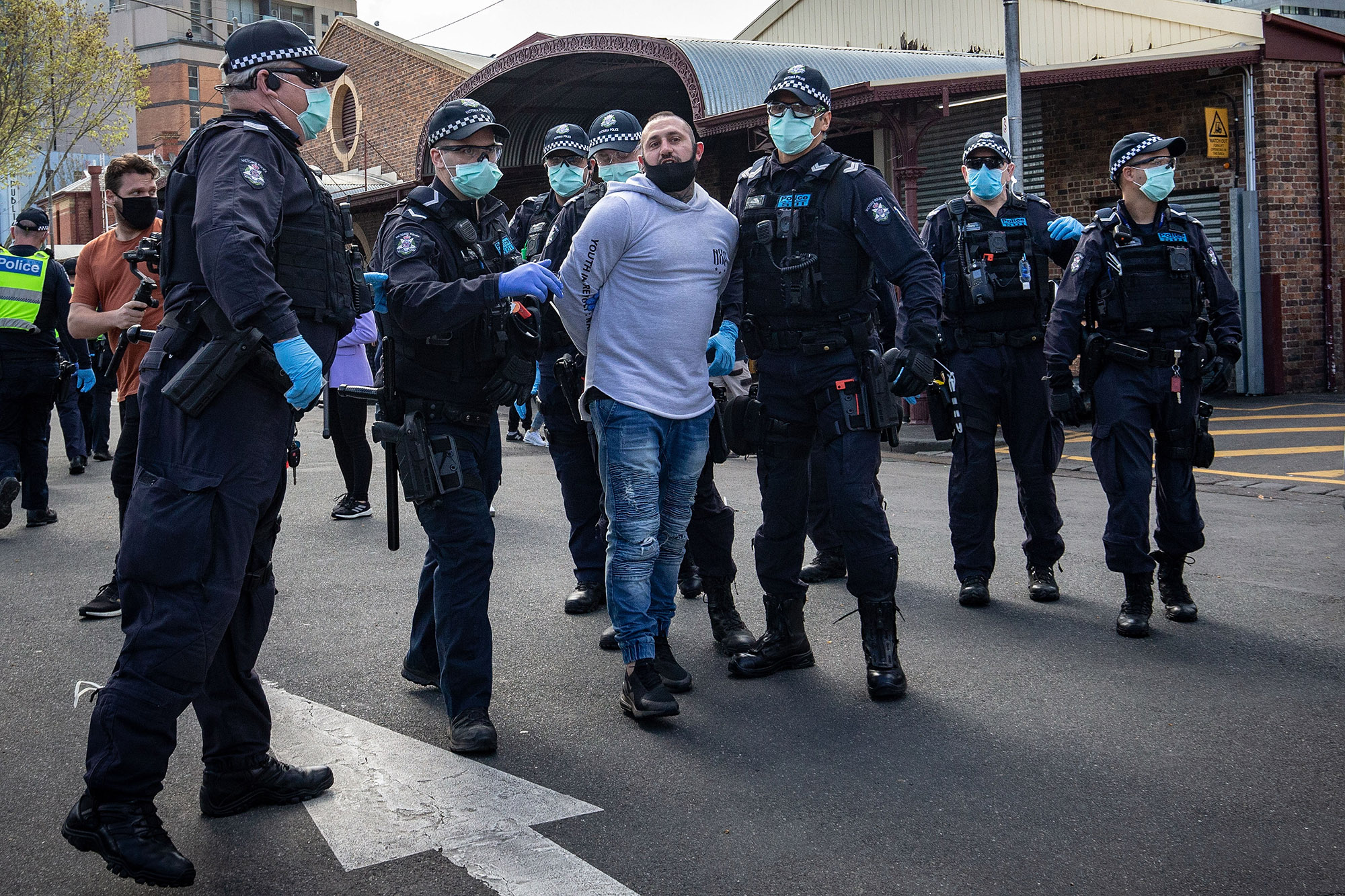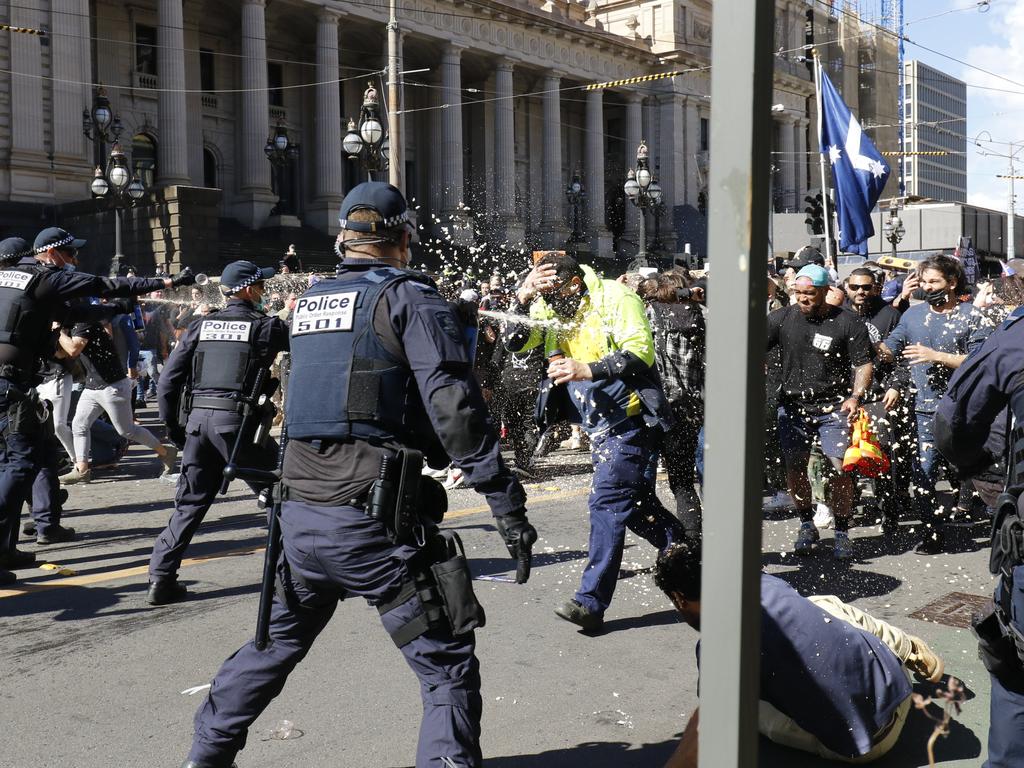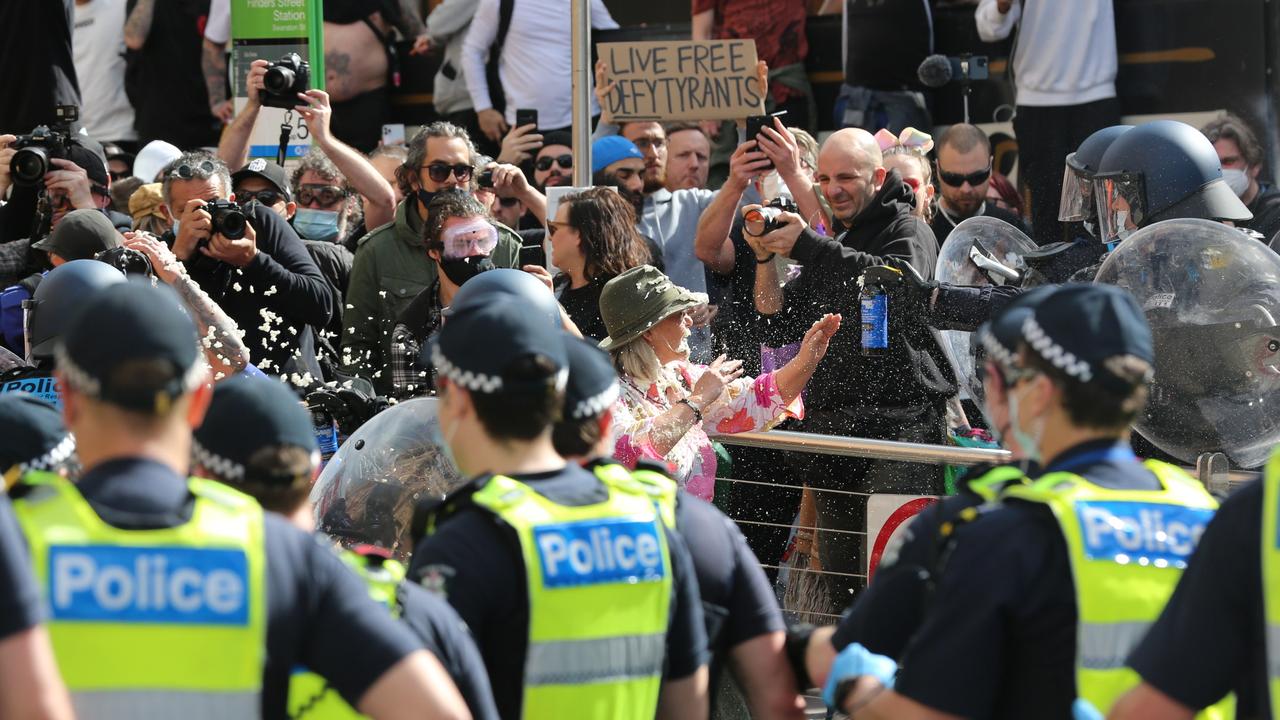Protests In Melbourne Today are capturing the city’s attention, with various groups voicing their concerns through diverse methods. This report delves into the locations, participants, demands, and methods employed, providing a comprehensive overview of these significant events. We’ll explore the historical context, comparing today’s actions to past protests and analyzing their impact on public opinion and government policy. We’ll also examine media coverage and public sentiment, considering the different perspectives and narratives surrounding these demonstrations.
The report will analyze potential short-term and long-term impacts, considering government responses and the challenges protesters may face. We’ll even offer a glimpse into a possible scenario for the protests’ evolution in the coming days, painting a picture of the unfolding situation. Finally, we’ll explore the visual aspects of the protests, detailing the atmosphere, symbolism, and overall mood to fully capture the essence of these demonstrations.
Current Events

Source: cnn.com
Protests are a vital part of a functioning democracy, allowing citizens to voice their concerns and demand change. Understanding the context, locations, and demands of these protests is crucial for informed civic engagement. Today, several protests are taking place across Melbourne, each with its own unique focus and objectives.
Protest Locations and Participants
Several locations across Melbourne are hosting protests today. These range from central city locations easily accessible to public transport to more localized demonstrations targeting specific issues in particular neighborhoods. The numbers of participants vary considerably depending on the specific protest and its appeal. Accurate figures are often difficult to obtain immediately due to the dynamic nature of these events.
However, estimations are provided below based on reports from news outlets and social media.
| Location | Estimated Participants | Focus |
|---|---|---|
| State Library of Victoria | 500-700 | Climate Change Action – demanding stronger government policies to mitigate climate change and transition to renewable energy. |
| Federation Square | 200-300 | Affordable Housing Crisis – protesting the lack of affordable housing options in Melbourne and calling for increased government investment in social housing. |
| St Kilda Beach | 100-200 | Protecting Coastal Environments – demonstrating against proposed developments that threaten local beaches and marine life. |
| Parliament House | 300-500 | Education Funding Cuts – protesting recent cuts to education funding and demanding increased investment in public schools and universities. |
Groups Involved and Grievances
A diverse range of groups and organizations are involved in today’s Melbourne protests. These include established environmental groups, community action organizations focused on housing affordability, student activist groups, and various independent coalitions. The grievances expressed are equally varied, reflecting the complex social and political landscape of the city. Many protests share common threads, such as concerns about government inaction on pressing social and environmental issues.
Protest Methods
The protests are employing a variety of methods to make their voices heard. These include traditional marches through the city streets, organized rallies with speeches and performances, and more static forms of protest like sit-ins at key locations. Many protests utilize social media to amplify their message and coordinate participation. The choice of method often depends on the specific aims of the protest and the desired level of disruption.
For example, a march aims to create visibility and momentum, while a sit-in aims to create a physical blockade and symbolize resistance.
Historical Context

Source: api.news
Today’s protests in Melbourne resonate with a history of civic engagement and activism. Examining similar protests from the past year provides valuable context for understanding the current climate and the potential impact of today’s demonstrations. By analyzing past successes and failures, we can gain insights into the strategies employed and the recurring themes that continue to drive public action.Understanding the historical context of Melbourne protests reveals patterns in public sentiment and government response.
The scale, methods, and outcomes of past protests offer a framework for analyzing the potential trajectory of today’s demonstrations. Analyzing these past events helps us assess the effectiveness of various protest strategies and the long-term influence on public opinion and policy decisions.
Examples of Past Protests and Their Outcomes
Several significant protests have taken place in Melbourne over the past year, each with unique characteristics and outcomes. These examples illustrate the diverse range of issues that galvanize public action and the varying degrees of success achieved through different protest strategies. Analyzing these case studies highlights the importance of strategic planning, sustained engagement, and effective communication in achieving desired outcomes.
Recurring Themes in Melbourne Protests
Several recurring themes have fueled repeated protests in Melbourne. These include concerns about climate change, social justice issues, housing affordability, and healthcare access. The persistence of these themes indicates the ongoing urgency of these issues and the public’s continued commitment to advocating for change. Understanding these persistent themes is crucial for predicting future protest activity and for developing effective strategies for addressing the underlying concerns.
Impact of Past Protests on Public Opinion and Government Policy, Protests In Melbourne Today
Past protests in Melbourne have demonstrably influenced both public opinion and government policy. Successful protests have raised awareness of critical issues, shifted public discourse, and pressured governments to implement policy changes. However, the impact of protests varies depending on factors such as the scale of participation, the clarity of messaging, and the government’s responsiveness. Examining this impact highlights the complex interplay between public activism, media coverage, and political decision-making.
Comparison of Three Past Melbourne Protests
The following table compares three significant protests in Melbourne over the past year, highlighting differences in scale, methods, and outcomes. This comparison provides a framework for understanding the diverse strategies employed and the varying degrees of success achieved. Note that the specific details and outcomes are subject to ongoing analysis and interpretation.
| Protest Topic | Scale (estimated participants) | Methods Employed | Significant Outcomes |
|---|---|---|---|
| Climate Change Rally (Example) | 10,000+ | March, speeches, petitions, social media campaign | Increased media attention, government commitment to further investigation into renewable energy sources |
| Housing Affordability Protest (Example) | 5,000 | Occupations, rallies, lobbying of local representatives | Increased public awareness, some policy adjustments to state housing programs |
| Indigenous Rights March (Example) | 2,000 | March, speeches, symbolic actions | Greater media attention on specific land rights issues |
Media Coverage and Public Sentiment: Protests In Melbourne Today
Media coverage of today’s Melbourne protests presented a diverse range of perspectives, reflecting the multifaceted nature of the demonstrations themselves. News outlets varied in their emphasis on specific aspects of the protests, from the stated goals of the organizers to the actions of individual participants. This resulted in a complex public narrative, influenced by both the media’s framing and the pre-existing beliefs of the audience.
Summary of Media Coverage and Perspectives
Major news outlets offered varying degrees of coverage, with some focusing on the scale and organization of the protests, while others highlighted specific incidents or counter-protests. For example, Channel 7’s evening news emphasized the disruption to traffic and potential safety concerns, while The Age provided a more in-depth analysis of the protestors’ demands and their historical context. Social media platforms, such as Twitter and Facebook, offered a more immediate and less filtered view, with a wider range of opinions and perspectives expressed.
This included live updates, personal accounts, and citizen journalism. The differing approaches created a complex media landscape where the same event was portrayed in various ways, influencing how different audiences interpreted the situation.
Dominant Narratives and Themes in News Reports and Social Media
Several dominant narratives emerged from the media coverage. One common theme was the protestors’ demands, focusing on specific policy changes or grievances. Another emphasized the potential disruption caused by the protests, highlighting concerns about public safety and inconvenience. Social media discussions frequently revolved around the legitimacy of the protest methods, with some praising the demonstration’s visibility and others criticizing the disruption or perceived extremism of certain participants.
The framing of these themes varied significantly across different media platforms, contributing to the overall diversity of public opinion.
Range of Public Reactions to the Protests
Public reaction to the protests ranged from strong support to outright condemnation, with many individuals holding more nuanced or neutral positions. Supporters often emphasized the importance of the protestors’ cause and their right to peaceful assembly. Neutral observers focused on the logistical impact of the protests, such as traffic disruption or economic consequences. Critical reactions frequently centered on concerns about the disruption, perceived violence, or the methods employed by the protestors.
Online discussions revealed a spectrum of opinions, with heated debates occurring across various social media platforms.
Media’s Influence on Public Opinion
The media’s portrayal of the protests undoubtedly influenced public opinion. The selection of specific events, the framing of the narrative, and the emphasis on particular aspects all shaped how viewers and readers interpreted the demonstrations. The use of emotionally charged language, the inclusion or exclusion of specific voices, and the presentation of visuals all played a crucial role in shaping public perception.
For example, focusing on violent incidents, even if isolated, can create a negative overall impression, while emphasizing peaceful demonstrations and the protestors’ motivations can foster greater public sympathy.
Hypothetical Social Media Posts
Supportive Post:
“Melbourne stands up! Today’s protest was a powerful display of solidarity for [State the cause of the protest]. We need to amplify the voices of those fighting for [State the key demand]. #MelbourneProtest #[RelevantHashtag] #StandForChange”
Critical Post:
“While I understand the frustration, today’s protest caused significant disruption to the city and negatively impacted many innocent people. Disruptive tactics like [mention a specific tactic] are counterproductive and undermine the cause. #MelbourneProtest #Concerns”
Potential Impacts and Outcomes
Today’s protests in Melbourne have the potential to significantly impact the city’s social fabric and political landscape, both in the short-term and long-term. The scale and nature of the consequences will depend on several factors, including the size and duration of the protests, the level of violence or disruption, and the government’s response. Understanding these potential impacts is crucial for assessing the overall effect of this demonstration.The short-term impacts could include disruptions to traffic and public transport, closure of businesses, and a general sense of unease within the community.
Depending on the intensity of the protests, there could also be injuries to protesters or police officers, and potential damage to property. These immediate effects can strain city resources and impact the daily lives of Melburnians.
Short-Term Impacts on Melbourne’s Society
The immediate consequences of the protests could include significant disruptions to daily life in Melbourne. Traffic congestion, particularly in the central business district, is highly likely, leading to delays and frustration for commuters. Businesses located near protest sites might experience closures or reduced sales due to the disruption. The overall atmosphere in the city could be tense and uncertain, impacting tourism and public confidence.
For example, similar protests in other major cities have resulted in temporary business closures and a drop in tourism revenue for several days following the event. The level of disruption will directly correlate with the scale and location of the protests.
Government and Authority Responses
The Victorian government and relevant authorities, including the police, will likely respond to the protests with a combination of strategies. These could range from a largely passive observation and facilitation of peaceful protest to a more active intervention if the protests turn violent or disruptive. Past responses to similar events in Melbourne suggest that police will aim to maintain order and protect public safety while allowing for the expression of dissent.
However, the specific response will depend on the nature and scale of the protests. A heavy-handed approach could escalate tensions, while a more conciliatory response might help de-escalate the situation. The government might also issue public statements addressing the protesters’ concerns.
Challenges Faced by Protesters
Protesters may face several challenges, including obtaining necessary permits for demonstrations, managing crowd control, and dealing with potential police intervention. They might also encounter counter-protests or opposition from individuals or groups with differing viewpoints. Successfully navigating these challenges requires careful planning, effective communication, and a commitment to peaceful and non-violent methods of protest. For instance, securing permits in advance can prevent legal repercussions, while establishing clear communication channels within the protest group can help maintain order and prevent misunderstandings.
Influence on Future Policy Decisions
The protests could significantly influence future policy decisions depending on their scale, impact, and the government’s response. If the protests gain widespread public support and media attention, they could put pressure on the government to address the underlying issues that prompted the demonstration. This pressure could lead to policy changes or further investigations into the matters raised by the protesters.
For example, large-scale protests in the past have resulted in significant policy reforms related to environmental protection, social justice, and economic inequality in various cities around the world.
Potential Scenario for the Next Week
Over the next week, the protests might evolve in several ways. If the initial protest is successful in garnering significant media attention and public support, it could inspire further demonstrations and acts of civil disobedience. Conversely, if the protest is met with a strong police response or fails to attract widespread attention, it might dissipate relatively quickly. Another possibility is that the protests could shift focus, incorporating new demands or strategies based on the initial outcomes.
The government’s response, media coverage, and public sentiment will all play crucial roles in shaping the trajectory of the protests in the coming days. For example, a similar protest in Sydney saw a significant increase in participation in subsequent days after positive media coverage, while a protest in Canberra dwindled after a forceful police response.
Visual Representation
The visual atmosphere of today’s Melbourne protests was a vibrant mix of organized displays and spontaneous expressions of dissent. A diverse range of signs, banners, and attire reflected the multifaceted nature of the grievances fueling the demonstrations. The overall effect was one of both determined resolve and creative, often emotional, communication.The protesters utilized a wide array of visual strategies to convey their message effectively.
This included the strategic deployment of color, imagery, and text, often combining these elements to create a powerful impact. The careful selection of slogans and symbols served to unify the protesters under a common cause while also allowing for individual expression.
Symbolism and Slogans
Protesters employed a variety of symbols and slogans to express their concerns. Common themes included environmental protection, economic inequality, and social justice. Many signs featured powerful imagery, such as stylized depictions of endangered species alongside corporate logos, visually connecting environmental degradation with specific industries. Slogans were concise and impactful, often utilizing rhyme or alliteration to enhance memorability.
For example, one particularly effective slogan seen repeatedly was “Climate Action Now,” printed in bold, easily readable lettering on large banners. Another recurring theme was the use of hand-drawn images, demonstrating a more personal and emotionally charged approach to visual communication.
Crowd Size and Behavior
The size of the protest varied throughout the day, peaking at an estimated 5,000 participants in the afternoon. While the overall mood was largely one of passionate engagement, the crowd remained largely peaceful and orderly. There was a palpable sense of collective purpose, with participants actively engaging in chants, song, and shared displays of solidarity. The atmosphere was energetic and charged, reflecting the intensity of feelings surrounding the issues at hand.
While some minor disagreements were observed, these were generally resolved amicably amongst participants.
A Specific Scene
One particularly striking moment occurred near the State Library. A group of young protesters, many adorned in brightly colored clothing and face paint, formed a spontaneous human chain across Swanston Street. The air buzzed with the rhythmic chanting of their slogans, their voices rising and falling in unison. The scent of freshly printed flyers mingled with the aroma of coffee from nearby cafes.
The vibrant colors of their signs and banners contrasted sharply against the grey stone of the library, creating a vivid visual contrast that underscored the intensity of their message. The rhythmic pounding of drums and the echoing chants filled the air, creating a powerful and unforgettable sensory experience. The overall feeling was one of both defiance and hope, a powerful demonstration of collective action.
Concluding Remarks

Source: api.news
Today’s protests in Melbourne represent a powerful expression of public sentiment, demanding attention to critical issues. The diverse methods employed, ranging from marches to rallies, highlight the depth of feeling and the determination of the participants. By understanding the historical context, analyzing media coverage, and considering potential impacts, we gain a clearer perspective on the significance of these events and their potential influence on Melbourne’s future.
The visual aspects further underscore the passionate energy and determination driving these demonstrations, leaving a lasting impression on the city’s landscape and its political discourse.
